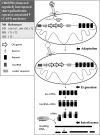The Role of Gene Editing in Neurodegenerative Diseases
- PMID: 29766738
- PMCID: PMC6038035
- DOI: 10.1177/0963689717753378
The Role of Gene Editing in Neurodegenerative Diseases
Abstract
Neurodegenerative diseases (NDs), at least including Alzheimer's, Huntington's, and Parkinson's diseases, have become the most dreaded maladies because there are no precise diagnostic tools or definite treatments for these debilitating diseases. The increased prevalence and a substantial impact on the social-economic and medical care of NDs propel governments to develop policies to counteract the impact. Although the etiologies of NDs are still unknown, growing evidence suggests that genetic, cellular, and circuit alternations may cause the generation of abnormal misfolded proteins, which uncontrolledly accumulate to damage and eventually overwhelm the protein-disposal mechanisms of these neurons, leading to a common pathological feature of NDs. If the functions and the connectivity can be restored, alterations and accumulated damages may improve. The gene-editing tools including zinc-finger nucleases (ZFNs), transcription activator-like effector nucleases (TALENs), and clustered regularly interspaced short palindromic repeats-associated nucleases (CRISPR/CAS) have emerged as a novel tool not only for generating specific ND animal models for interrogating the mechanisms and screening potential drugs against NDs but also for the editing sequence-specific genes to help patients with NDs to regain function and connectivity. This review introduces the clinical manifestations of three distinct NDs and the applications of the gene-editing technology on these debilitating diseases.
Keywords: Alzheimer’s disease (AD); Huntington’s disease (HD); Parkinson’s diseases (PD); clustered regularly interspaced short palindromic repeats–associated nucleases (CRISPR/CAS); neurodegenerative diseases (NDs); transcription activator-like effector nucleases (TALENs); zinc-finger nucleases (ZFNs).
Conflict of interest statement
Figures



References
-
- Fan HC, Chen SJ, Harn HJ, Lin SZ. Parkinson’s disease: from genetics to treatments. Cell Transplant. 2013;22(4):639–652. - PubMed
-
- Fan HC, Ho LI, Chi CS, Chen SJ, Peng GS, Chan TM, Lin SZ, Harn HJ. Polyglutamine (polyq) diseases: genetics to treatments. Cell Transplant. 2014;23(4–5):441–458. - PubMed
-
- Menken M, Munsat TL, Toole JF. The global burden of disease study: implications for neurology. Arch Neurol. 2000;57(3):418–420. - PubMed
Publication types
MeSH terms
Substances
Grants and funding
LinkOut - more resources
Full Text Sources
Other Literature Sources
Medical

